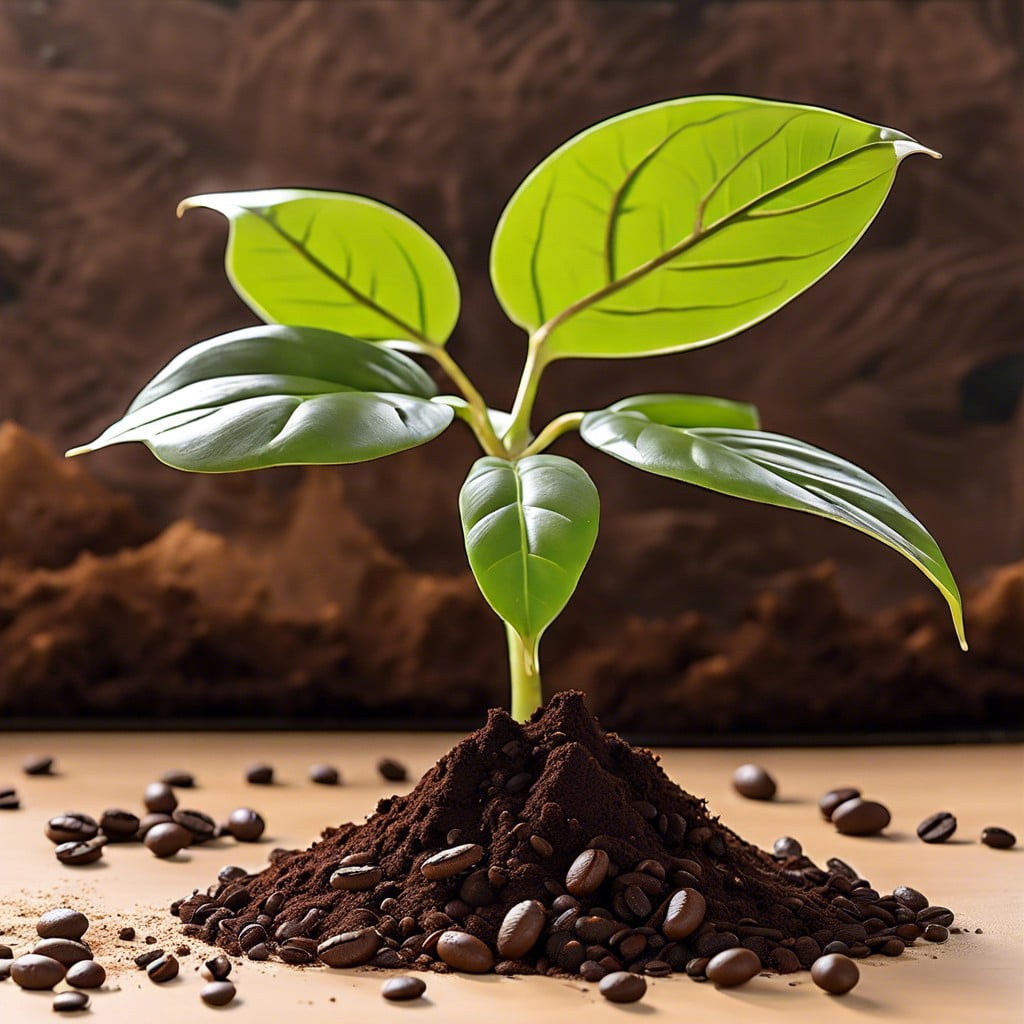Learn how to utilize spent coffee grounds to enrich your garden soil and give your plants a boost.
Benefits of Using Coffee Grounds On Plants

Coffee grounds can give your greenery a real leg up. For starters, they add nitrogen to the soil, a nutrient that acts like a green smoothie for your plants, helping them sprout luscious leaves. The gritty texture of coffee grounds improves soil aeration and drainage, ensuring roots can breathe easy and sip on just the right amount of water.
Worms love coffee almost as much as we do. Adding grounds to the soil is like throwing a worm banquet, encouraging these helpful critters to thrive and naturally till your earth. Also, the use of coffee grounds may discourage garden pests. The strong scent is like a “keep out” sign for ants and slugs, making your garden their least favorite coffee shop.
Lastly, grounds can be a boon for acid-loving plants, tipping the pH scale to their favored acidic side. Think of blueberries, azaleas, and roses sipping on a tangy cup of joe to get their acid fix. However, moderation is key—too much coffee can sour the soil, so sprinkle thoughtfully.
Challenges of Using Coffee Grounds On Plants
Coffee grounds can sometimes be more of a foe than a friend to your plants. They are acidic, which may not sit well with alkaline-loving flora. Adding coffee grounds directly to the soil can also hinder plant growth, as they can form a barrier that resists water infiltration when applied in layers.
Moreover, fresh coffee grounds contain compounds that are toxic to some plants. This can spell trouble for your garden’s inhabitants if not composted beforehand. And for those who think more is better—hold your horses! Excessive application of coffee grounds can lead to nitrogen depletion as they decompose, robbing your plants of this essential nutrient.
To navigate these choppy waters, apply coffee grounds in moderation, mix them with other organic materials, and observe your plants for any signs of distress. Sometimes, they’ll need a breather from the coffee buzz just like we do after one cup too many.
How to Use Coffee Grounds On Houseplants
Sprinkle dry grounds around the soil surface, then gently mix them with the top layer of soil to avoid mold. Coffee grounds can lower pH levels slightly, making them beneficial for acid-loving houseplants like African violets or philodendrons.
Limit application to once a month to circumvent nutrient imbalance. A pinch is often enough for a small houseplant. Overuse can lead to soil compaction, reducing aeration and drainage.
Use grounds as a slow-release fertilizer. Rich in nitrogen, they gradually enrich the soil as they decompose, aiding plant growth. Avoid direct contact with plant stems to prevent possible burn from concentrated acidity.
Consider coffee grounds an indoor repellent for pests like ants and slugs. Their abrasive texture and strong scent are deterrents, providing a non-toxic protective barrier for your beloved greens.
Monitor plant health after application. Observe changes in leaf color, growth, and overall vigor. Adjust coffee ground usage accordingly to maintain a perky, robust growth cycle.
Composting Coffee Grounds
Transforming your morning brew’s leftovers into a nutrient-rich compost enhances soil quality and promotes plant growth. Coffee grounds add organic material, improving drainage, water retention, and aeration in the soil. They are particularly high in nitrogen, an essential nutrient for plant development, contributing to the overall fertility of the compost mix.
Integrating coffee grounds into your compost pile is straightforward. Aim for a balanced mix of greens (coffee grounds) and browns (dry leaves, paper, or straw) in your compost. This balance helps maintain the right carbon-to-nitrogen ratio, which is crucial for effective composting. The mantra to keep in mind is to “stir and layer” – aerate the compost regularly to speed up the decomposition process and layer the coffee grounds with browns to avoid mold growth.
It’s a misconception that coffee grounds lower the pH level of soil or compost. While fresh grounds are acidic, once used, they’re nearly neutral in pH. So, gardeners can rest easy, knowing they are unlikely to acidify their compost or soil by adding used coffee grounds.
Given their fine texture, it’s wise not to overdo it. Excessive amounts can clump, potentially restricting airflow in the compost pile. Sprinkle them lightly, as if adding seasoning to a dish, to get the best out of their properties. Using this morning ritual byproduct within your compost is an excellent way to recycle and give back to your garden, forming a natural cycle that benefits both your garden and the environment.
Tips to Use Coffee Grounds in Your Garden
Sprinkle lightly around plants as a gentle fertilizer. The nitrogen-rich composition bolsters plant growth, but ensure a light hand to prevent mold.
Balance the acidity by mixing grounds with wood ash or lime. Plants like hydrangeas may love a little acidity, but for those that don’t, a pH-balanced soil is key.
Encourage earthworm activity by integrating grounds into garden beds. Earthworms thrive with coffee grounds, naturally aerating soil and breaking down organic material.
Deter pests with a barrier of grounds. Critters like slugs and ants aren’t fans of coffee’s texture or acidity. A well-placed line could save your greens.
Combine with mulch to minimize weed growth. When used with straw or wood chips, coffee grounds suppress weeds, keeping your garden neat with less effort.
Always compost in moderation. Despite their benefits, adding too much can harm helpful microorganisms. Blend with other materials for a healthy compost mix.